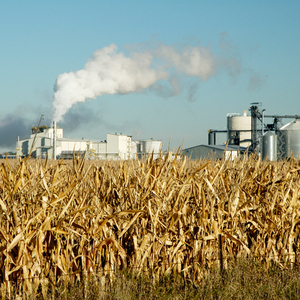USDA reduces forecast for corn use in ethanol

September 12, 2022
BY Erin Krueger
The USDA reduced both its forecast for 2022-’23 corn use in ethanol and its estimate for 2021-’22 corn use in ethanol in its latest World Agricultural Supply and Demand Estimates report, released Sept. 12.
The agency said its current 2022-’23 corn outlook is for lower supplies, smaller feed and residual use, reduced exports and corn used for ethanol, and tighter ending stocks.
Projected beginning stocks for 2022-23 are 5 million bushels lower based on essentially offsetting export and corn used for ethanol changes for 2021-’22. Corn production for 2022-’23 is forecast at 13.9 billion bushels, down 415 million from last month on reductions to harvested area and yield. The national average yield is forecast at 172.5 bushels per acre, down 2.9 bushels. Harvested area for grain is forecast at 80.8 million acres, down 1 million.
Advertisement
Total U.S. corn use is cut 250 million bushels to 14.3 billion. Feed and residual use is lowered 100 million bushels based on a smaller crop and higher expected prices. Exports are cut 100 million bushels to 2.3 billion.
The USDA currently expects 5.325 billion bushels of corn to go to ethanol production in 2022-’23, down 50 million bushels when compared to the August WASDE. The agency also reduced its estimate for 2021-’22 corn use in ethanol to 5.33 billion bushels, down slightly from the 5.35-billion-bushel estimate included in the August WASDE. Corn use for ethanol production was at 5.033 billion bushels in 2020-’21.
Advertisement
With supply falling more than use for 2022-’23, ending stocks are revised down 169 million bushels to 1.2 billion. The season-average corn price received by producers is raised 10 cents to $6.75 per bushel.
Foreign corn production is forecast higher with increases for China, Ukraine, Canada and Mozambique more than offsetting reductions for the EU and Serbia. China corn production is raised as abundant rainfall in key northeast provinces and the North China Plain boost yield prospects. Ukraine corn production is raised with an increase in yield expectations while Canada is higher based on greater indicated area. EU corn production is lowered based on reductions for France, Romania and Germany.
Larger corn exports are expected for Ukraine in 2022-’23, with a reduction in the U.S. Corn imports are lowered for Canada and Vietnam. Foreign corn ending stocks are raised 2.2 million tons to 273.6 million, mostly reflecting increases for China and India that are partially offset by declines for Ukraine, the EU and Thailand. World corn ending stocks, at 304.5 million tons, are down 2.2 million.
Related Stories
The U.S. EPA on July 8 hosted virtual public hearing to gather input on the agency’s recently released proposed rule to set 2026 and 2027 RFS RVOs. Members of the biofuel industry were among those to offer testimony during the event.
The USDA’s Risk Management Agency is implementing multiple changes to the Camelina pilot insurance program for the 2026 and succeeding crop years. The changes will expand coverage options and provide greater flexibility for producers.
EcoCeres Inc. has signed a multi-year agreement to supply British Airways with sustainable aviation fuel (SAF). The fuel will be produced from 100% waste-based biomass feedstock, such as used cooking oil (UCO).
The USDA’s National Agricultural Statistics Service on June 30 released its annual Acreage report, estimating that 83.4 million acres of soybeans have been planted in the U.S. this year, down 4% when compared to 2024.
SAF Magazine and the Commercial Aviation Alternative Fuels Initiative announced the preliminary agenda for the North American SAF Conference and Expo, being held Sept. 22-24 at the Minneapolis Convention Center in Minneapolis, Minnesota.
Upcoming Events










